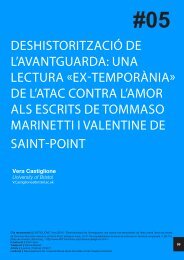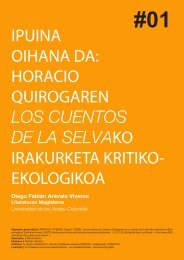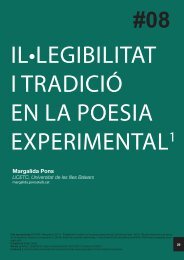03 - 452ºF
03 - 452ºF
03 - 452ºF
Create successful ePaper yourself
Turn your PDF publications into a flip-book with our unique Google optimized e-Paper software.
Here, Heinrich hypothetically surrenders to the media message,<br />
which he believes to be truer than the fact that it is actually raining at<br />
this moment. This dialogue shows Jack’s dilemma as a late modernist<br />
(dis)placed in a postmodernist society. He tries and struggles to cling<br />
to the beliefs and metanarratives of science and common sense.<br />
He comes into clash with a world dominated by the image and<br />
ruled by the simulacrum; a world characterized, in Lyotard’s motto,<br />
by «the incredulity towards metanarratives» (Lyotard, 1979: xxiv).<br />
This is what postmodernity is all about. Jack tries to defend what<br />
he believes in, based on the empirical evidence of his senses that<br />
it really is raining right here and right now, and that, according to<br />
him, it is unacceptable and not commonsensical that «just because<br />
it’s said on the radio… we have to suspend belief in the evidence<br />
of our senses» (DeLillo, 1985: 22-3). Heinrich, from the perspective<br />
of a postmodernist, answers his father that this contemporary life of<br />
simulacra has found human senses wrong most of the times, it is the<br />
image, the broadcast, the computer that we have to believe. Heinrich<br />
concludes this by saying, «this has been proved in the laboratory»<br />
(DeLillo, 1985: 23).<br />
Though a late modernist, Jack is not able to escape the influence and<br />
the hyperreality of the simulacrum. There is a considerable difference<br />
between Jack’s life before and after his computerized checkup<br />
during the «Airborne Toxic Event» by the «SIMUVAC» team. Jack’s<br />
life changes according to the data on the screen, especially when<br />
these data ensure his exposure to the poisonous gas, «Nyodene<br />
Derivative,» and that his death becomes impending. Jack wonders<br />
how this happens, and the technician answers him that, «I didn’t say<br />
it. The computer did. The whole system says it.» (DeLillo, 1985: 141)<br />
The way the technician says this is as if he is referring to something<br />
that is all-true and all-knowing: It is the simulacrum; it is the surrogate<br />
omniscient god. To Jack, it is something he doesn’t accept easily,<br />
and it stirs in him great fear and restlessness, but deep down, he<br />
starts to believe that this hyperreality «just means you are the sum<br />
total of your data. No man escapes that» (DeLillo, 1985: 141).<br />
The simulacrum, which becomes the dominant feature of<br />
contemporary life, expands to include people’s feelings of illnesses.<br />
People have come to believe simulacra more than their direct<br />
personal perceptions even about the symptoms of illnesses. Steffie<br />
and Denise suffer from déjà vu after the «Airborne Toxic Event», and<br />
Babette suggests that the solution to this is to keep the radio turned<br />
off,<br />
Living in a simulacrum: how TV and the supermarket redefines reality in Don DeLillo’s White noise - Ahmad Ghashmari<br />
<strong>452ºF</strong>. #<strong>03</strong> (2010) 172-186.<br />
178










